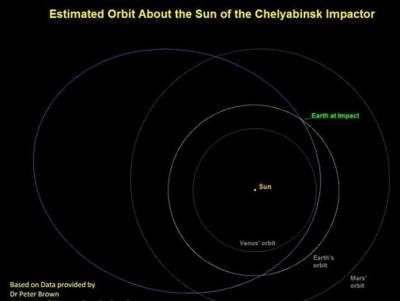Wed, Feb 20, 2013
Largest Such Event In More Than A Century
The first firm details of the meteor impact which occurred Friday in Russia, the largest in more than a century, are becoming clear. ESA is carefully assessing the information as crucial input for developing the Agency’s asteroid-hunting effort.

According to the ESA, at 0320 GMT on February 15, a natural object entered the atmosphere and disintegrated in the skies over Chelyabinsk, Russia. Extensive video records indicate a northeast to southwest path at a shallow angle of 20° above the horizontal. The entry speed is estimated at around 18 km/s, or more than 40,000 miles per hour. According to calculations by Peter Brown at the University of Western Ontario, Canada, drawing on extremely low-frequency sound waves detected by a global network, the object is estimated to have been about 55 feet across with a mass of about 10,000 tons when it entered the atmosphere. It exploded with a force of nearly 500 kilotons of TNT – some 30 times the energy released by the Hiroshima atomic bomb – at an altitude of under 65,000 feet.
With our current understanding of near-Earth objects, ESA says that events of this magnitude are expected once every several of tens to 100 years.
Detlef Koschny, who monitors near-Earth objects for ESA’s Space Situational Awareness (SSA) program, said that an the majority of the damage was caused by the airburst resulting in window breakage and some structural damage in downtown Chelaybinsk. Normally, some damage begins to occur at around five times normal air pressure at sea level. Widespread window damage is expected around 10–20 times this value. As the explosion and fireball progressed along a shallow trajectory, the cylindrical blast wave would have propagated directly to the ground and would have been intense.
Koschny said the terminal part of the explosion probably likely occurred almost directly over Chelyabinsk. This was perhaps the single greatest contributor to the blast damage. "We are waiting for confirmation from the Russian authorities that pieces of the object – bits of meteorite – have been found in the region," he said. "We’re unaware of any media reports of anyone or any structure being hit by any debris from the object itself."
(Graphic provided by ESA)
More News
“We achieved full mission success today, and I am so proud of the team. It turns out Never Tell Me The Odds had perfect odds—never before in history has a booster this >[...]
NonDirectional Beacon An L/MF or UHF radio beacon transmitting nondirectional signals whereby the pilot of an aircraft equipped with direction finding equipment can determine his/h>[...]
About 5ft Above Ground Level, The Airplane Stalled, And The Left Wing Dropped Analysis: The pilot reported that this flight was conducted as part of phase 1 flight testing of the n>[...]
Aero Linx: Brodhead Pietenpol Association The Brodhead Pietenpol Association is a newly reorganized (in 2017) non-profit educational corporation that grew and developed from an ear>[...]
Also: VerdeGo Contract, Medi-Carrier, Gambit 6 UCAV, Blade Urban Air Mobility Pilot Archer Aviation has inked a deal for control of Hawthorne Municipal Airport (HHR), also known as>[...]
 Aero-News: Quote of the Day (11.17.25)
Aero-News: Quote of the Day (11.17.25) ANN's Daily Aero-Term (11.17.25): NonDirectional Beacon
ANN's Daily Aero-Term (11.17.25): NonDirectional Beacon NTSB Final Report: Fred L Wellman CH 750 Cruzer
NTSB Final Report: Fred L Wellman CH 750 Cruzer ANN's Daily Aero-Linx (11.17.25)
ANN's Daily Aero-Linx (11.17.25) Airborne-NextGen 11.11.25: Archer Buys Hawthorne, Joby Conforms, Stranded Astros
Airborne-NextGen 11.11.25: Archer Buys Hawthorne, Joby Conforms, Stranded Astros



